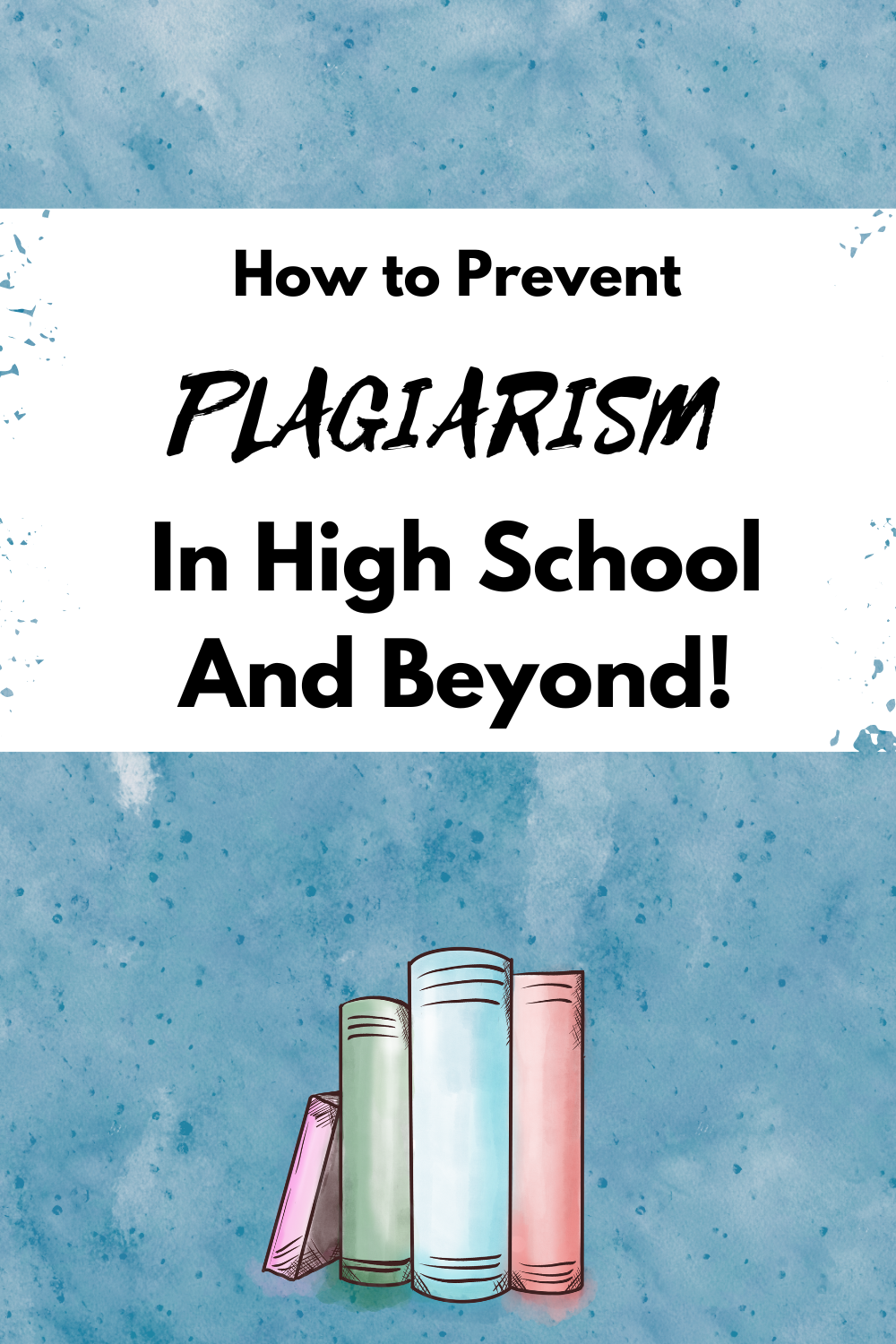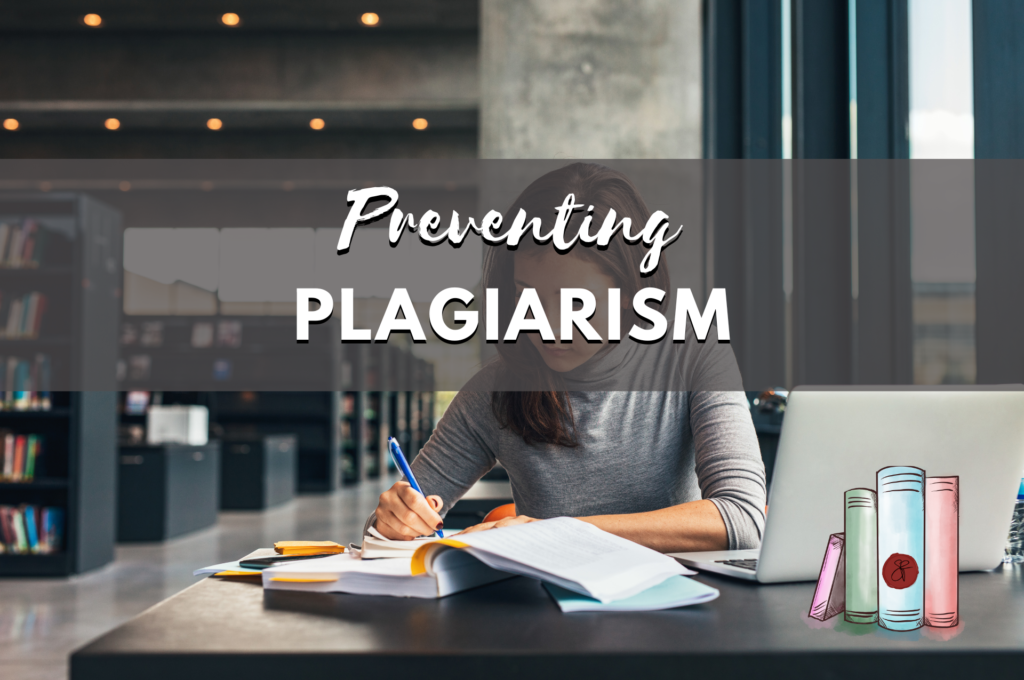The eternal question as an educator asks how to prevent plagiarism? Especially now that accessing the work of others is so easily to attain with programs like ChatGPT. The quickest answer is to have conversations about what plagiarism is, how it affects the people plagiarized, and the consequences of plagiarism within high school and beyond.
With applications like CHAT GPT which can write (although not well or with heart) essays, short stories, reports, descriptions, recipes, and beyond, falling down the rabbit hole of research, reporting, and writing integrity may feel intimidating for many teachers, writers, and fellow creatives. But it’s important to have these conversations with our next generations of readers, writers, and leaders, so they may have a deeper understanding of academic integrity.

What Is Plagiarism and Academic Integrity?
Plagiarism is defined by Kent State as happening, “when a writer deliberately uses someone else’s language, ideas, or other original (not common-knowledge) material without acknowledging its source” (Council of Writing Program Administrators, 2014).
So if I had researched how to define plagiarism, found the article from Kent State, then copied and pasted the quote without using quotation marks or including the direct link to the article, (which I did do), then that would be an example of me knowingly using content from someone else without stating where I received that information.
As for academic integrity, Turnitin, (not a sponsor of this blog) which is a very famous tool educators have used for well over twenty years, has academic integrity as the heart of its mission. Turnitin defines academic integrity as, “a commitment to honesty, trust, fairness, respect, responsibility, and courage” (Turnitin 2023).
I recently went through a unit on preventing plagiarism for my 9th and 10th grade class. Throughout the duration of our essay writing unit, we talked about plagiarism. I asked my students, “How would you feel if someone stole something you worked really hard on?”
My students all expressed that they would feel hurt by the person’s disregard for their feelings, stealing their work without acknowledging their efforts. I explained to my students that this is the general concept of plagiarism, when we take from someone else’s work without giving them credit for the time, effort, and care they poured into their project, article, novel, etc.
The conversation circled around to the ethical nature of artificial intelligence. I referenced how in Mary Shelley Wollstonecraft’s The Modern Prometheus, also known as Frankenstein, Dr. Frankenstein creates something because he can, but does not stop to ask himself if he should. With something like CHAT GPT, I rationalized with my students that when they work with AI, to pause and ask themselves:
- What is my end goal with this project?
- Am I going to say this is my original work? Is this something that’s just for me – like asking the software for a suggested reading list?
- Or is this something I intend to put out into the universe?
CHAT GPT is an intriguing beast – it can be very helpful as a search engine or as a stepping stone to building assignments, product descriptions, checking email etiquette, and finding weekly meal plans, but where it becomes dangerous is when people use what it or other AI bots like it word-for-word and claim the piece to be their original work. I have had high school students try to pass AI essays by me, but it is always clear when they turn in assignments that are not in their voice cc
How to Catch Plagiarism as a Teacher
Some of the tactics my school has taken to deter AI essays, is to have our students work on their hand-written drafts in class and to turn those in before class is over. This way, we at least have an idea of the direction of the paper and we know that it was written in front of us. Another strategy we have used is to have our students turn in their drafts, if done at home, as handwritten pieces. We have still encountered students who have tried to use AI generators as their homework, but in this case, we feel that the students may have learned something by copying the answers word for word, and two, that we are still able to distinguish their voice from that of the software’s. If your school isn’t using this yet, recommend using something like Turnitin, which is a tool that scans documents to determine what is original, improperly sited, or plagiarized. The documents turned in are run through the scanner and a report is generated then provided to the administrator of the account. As of the time of this post, it is my understanding that AI generated content is tougher to catch with these scans as they are more like paraphrasing and cobbling together the works of others, but I have faith that programmers will be able to tell if these documents are original content to the student or AI.
AI Generators Beyond the Classroom
Beyond the classroom, creative and academic integrity still come into play. There are AI-generated book covers emerging onto shelves and I have seen more and more publication houses specifically state in their submission guidelines begging people to not submit works composed by bots. I’ve heard stories about submissions opening and being flooded by bots submitting pieces, which takes away from the opportunities of other authors who have worked hard to generate original content. For creatives, like for cover creators, who spend hours of their lives creating beautiful, custom covers for their clients, AI generated covers threatens their line of work and the art that they craft and create.
Using AI to generate a story, poem, or essay is cheating in real life and, as educators, we must define and describe the differences for our students, so the next generations understand the ramifications of claiming the work of others as their own. So how do we maintain academic and creative integrity?
This returns us to the questions I asked my students about what the purpose of their project is; if they are using AI to generate a piece of work for the masses that they are claiming to be their own, then their academic integrity is in jeopardy. So before you click enter when using AI, consider how you intend to use your work. I’m not making a declaration that all AI is evil – I enjoy the suggestions Canva makes for my designs or that Google makes when I’m writing an email, or when Grammarly chimes in to say I could tighten my sentences (not sponsored by Grammarly, Canva, or Google), and I have used ChatGPT as a starting point for classroom activities and product descriptions, BUT those activities are not for sale in my Teachers Pay Teachers or my website’s stores.
So the moral of the story, use AI with caution and do your research to ensure what you’re submitting or posting as your own is within the boundaries of your academic integrity and the community you are operating within.
Let me know how you feel about plagiarism and artificial intelligence in the comments below!
Cheers!
Sarah


